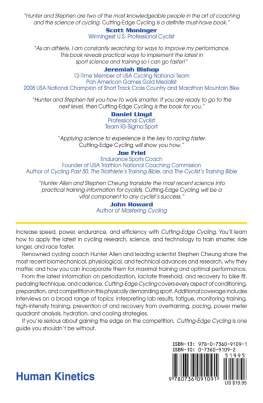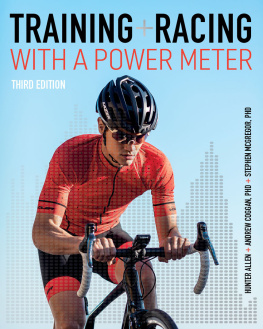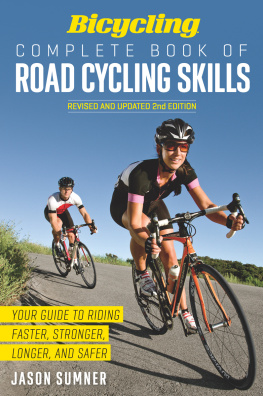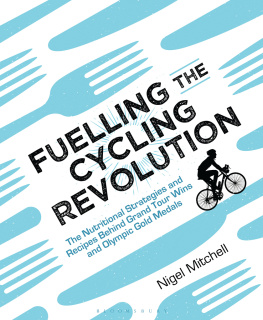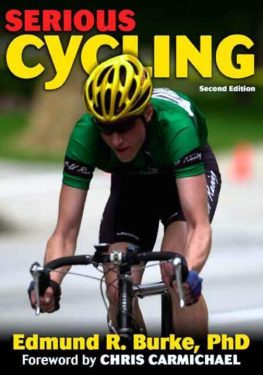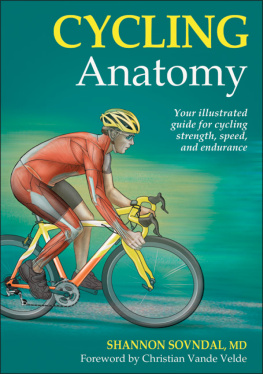Library of Congress Cataloging-in-Publication Data
Allen, Hunter.
Cutting-edge cycling / Hunter Allen, Stephen S. Cheung, PhD.
p. cm.
Includes bibliographical references and index.
ISBN 978-0-7360-9109-1 (soft cover) -- ISBN 0-7360-9109-2 (soft cover)
1. Cycling--Training. I. Cheung, Stephen S., 1968- II. Title.
GV1048.A53 2012
796.6--dc23
2011049602
ISBN-10: 0-7360-9109-2 (print)
ISBN-13: 978-0-7360-9109-1 (print)
Copyright 2012 by Hunter Allen and Stephen S. Cheung, PhD
All rights reserved. Except for use in a review, the reproduction or utilization of this work in any form or by any electronic, mechanical, or other means, now known or hereafter invented, including xerography, photocopying, and recording, and in any information storage and retrieval system, is forbidden without the written permission of the publisher.
The web addresses cited in this text were current as of January 2012, unless otherwise noted.
Acquisitions Editor: Tom Heine; Developmental Editor: Carla Zych; Assistant Editor: Claire Marty; Copyeditor: Bob Replinger; Indexer: Nan N. Badgett; Permissions Manager: Martha Gullo; Graphic Designer: Bob Reuther; Cover Designer: Keith Blomberg; Photographer (cover): Peter Blakeman/Action Plus/Icon SMI; Photo Asset Manager: Laura Fitch; Visual Production Assistant: Joyce Brumfield; Photo Production Manager: Jason Allen; Art Manager: Kelly Hendren; Associate Art Manager: Alan L. Wilborn; Illustrations: Human Kinetics, unless otherwise noted; Printer: McNaughton & Gunn
Human Kinetics books are available at special discounts for bulk purchase. Special editions or book excerpts can also be created to specification. For details, contact the Special Sales Manager at Human Kinetics.
Printed in the United States of America 10 9 8 7 6 5 4 3 2 1
The paper in this book is certified under a sustainable forestry program.
Human Kinetics
Website: www.HumanKinetics.com
United States: Human Kinetics
P.O. Box 5076
Champaign, IL 61825-5076
800-747-4457
e-mail:
Canada: Human Kinetics
475 Devonshire Road Unit 100
Windsor, ON N8Y 2L5
800-465-7301 (in Canada only)
e-mail:
Europe: Human Kinetics
107 Bradford Road
Stanningley
Leeds LS28 6AT, United Kingdom
+44 (0) 113 255 5665
e-mail:
Australia: Human Kinetics
57A Price Avenue
Lower Mitcham, South Australia 5062
08 8372 0999
e-mail:
New Zealand: Human Kinetics
P.O. Box 80
Torrens Park, South Australia 5062
0800 222 062
e-mail:
E5089
For all the cyclists and racers who want to improve. HHA
For Debbie, my tandem partner on and off the bike. SSC
Contents
L ook through the archives of your favorite cycling photographer or magazine. The feel and ambience of hard athletes performing a hard sport remains the same, but the overall look of the sport today is far different from years past. Except for the basic diamond shape of the frame, bicycles are almost completely unrecognizable from 20 or even 10 years agofrom clipless pedals, brake lever and electronic shifting, aerodynamic road bikes and time trialspecific bikes, oversized and integrated headsets and bottom brackets, eleven-cog cassettes, compact cranksets and bike geometries, ceramic bearings, and wind tunnels to pretty much carbon everything. The dizzying pace of technological improvements has been such that cycling has often been likened to Formula 1 racing on two wheels, and this focus on technology is one of the underlying fascinations of the sport for many people.
Although the techno-geek angle within cycling continues to advance by leaps and bounds, the basic awareness and application of the science of training and fitness is unfortunately lagging behind for many amateurs and even professional cyclists. True, many cyclists would never head out for a ride without their bike computers, heart rate monitors, or power monitors. But numbers are just random digits without any meaning unless cyclists have the knowledge and understanding of what the values mean and how to use that knowledge to their advantage. Many athletes are still stuck in variations of the just ride more and harder mentality of training. Meanwhile, despite the scientific advances in equipment, which result in the ascendance of designs that prove better, training itself continues to be rife with old-school ideas that seem to gain added cachet simply because theyre old. These ideas include such chestnuts as riding long steady distances and avoiding intensity in the off-season, riding a fixed gear to improve pedaling technique on the road, and using the knee over the pedal spindle as the optimal seat setback position. Such ideas and beliefs may or may not have merit, but rather than examine the evidence, many coaches and athletes blindly accept them simply because theyve been handed down through the generations.
This concept of an evidence-based approach to cycling science and training is the philosophy underlying this book. Our goal is to bring a science-first perspective to cycling by digging into the scientific basis behind concepts such as lactate threshold, periodization, bike positioning, pedaling technique and cadence, nutrition, and recovery. From there, we develop proven and practical strategies to enhance your performance on the bike. Our hope is that this book will be equally useful to athletes and coaches by creating a common knowledge set and improving communication between the two parties and ultimately the performance of both. Just as a public that is better educated about health can cause doctors to become better educated themselves and more accountable, informed athletes and coaches spur one another to greater heights. We hope to increase the awareness of and appreciation for cycling sport science among athletes of all levels. Throughout the book, we not only examine the science but also present it in ways that are accessible and practical regardless of your level or experience. Case studies of individual cyclists illustrate how various concepts come into play when the rubber hits the road.

